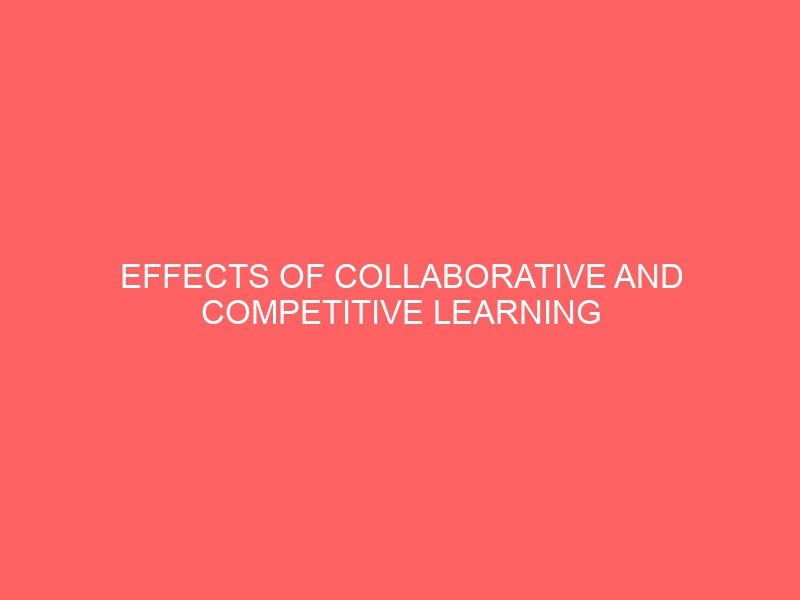Description
CHAPTER ONE INTRODUCTION Background of the Study Science Education in Nigeria dates back to the pre-independent days. It is the training given to individuals in order to enable them appreciates their environment and how to become useful to themselves and the society at large. According to Anegbe and Adeoye (2006) the Nigerian child is introduced to science right from the primary school. The essence is to enable the learner to develop interest in science, learn science, ?do? science and contribute effectively to the scientific and technological development of the nation. The foundation of science is presented to the learner at the basic level of education. The name Basic level of education was introduced into the Nigerian educational system under the Universal Basic Education (UBE) program. UBE is a reformed program in Nigeria?s basic education delivery system, (from primary one to junior secondary 3) designed to reinforce the implementation of the National Policy on Education (NPE) in order to provide greater access and ensure quality learning throughout the federation as it is free and compulsory (Adomeh, Arhedo & Omoike, 2007). The structure of the UBE program is made up of three levels in the following sequence; lower basic education (primary 1-3), middle basic education (primary 4-6) and upper basic education (junior secondary school (JSS) 1-3). Following the declaration by the Federal Government of Nigeria for the introduction of 9-year free and compulsory basic education structure which cover the primary and junior secondary school, strategies have been put in place by the Nigerian Education Research and Development Council (NERDC) to re-structure and re-align the school curricula for the 9-year basic education 1 (Obioma, 2006). A total of 19 curricula have been produced to cover the Lower basic (years 1-3)middle basic (years 4-6) and upper basic or Junior Secondary School (JSS) (years 7-9).One of the core and compulsory subjects in the new curriculum is Basic Science and Technology.The subject is presented to the learner at the lower basic level as Basic Science and Technologywhile it is taught at the middle basic level as Basic Science. However, at the upper basic level, thesubject is presented to learners as separate entities in the form of Basic Science, and BasicTechnology. The aim of separating the two concepts, according to Obioma, Adeniyi, Lawal,Odumuh, Ikegulu, Nwabueze, and Chijioke (2008) is to specially emphasize and strengthentechnology and entrepreneurship. However, these science concepts cannot be fully achieved withoutlearners having adequate knowledge of Basic Science. According to NERDC (2007), the overall objectives of the Basic Science and Technology curriculum are to enable learners to: -Develop interest in science; -Acquire basic knowledge and skills in science; -Apply scientific knowledge and skills to meet societal needs; -Take advantage of the numerous career opportunities offered by science; -Become prepared for further studies; The enumerated objectives, among other reasons, are supposed to prepare upper basic students for the study of science at the senior secondary school level. This could be one of the reasons why the contents of the Basic Science and Technology curriculum are sequenced in spiral form beginning with the simplest to the most complex. According to Hamza & Mohammed (2011), it was aimed at sustaining the interest of the learner. This assertion is however yet to be realized considering the fact that research reports revealed students? achievement in secondary school science to be low. Science educators have identified some of the factors responsible for students? low achievement and lack of interest in science. According to Dajal & Rinmark (2002) and Danjuma (2009), solutions have been proffered but the problem is yet to be solved. The issue could probably be related to the inability of the students to develop interest in the learning of basic science which is the foundation of science in Nigeria. This is because it is likely that without developing and sustaining the learners? interest, the objectives of Basic Science might not be achieved. If that is the case, then it may be difficult to achieve the objectives of senior secondary school science whose pre-requisite is Basic Science. Developing and sustaining students? interest in science is necessary for meaningful achievement to occur. Interest, as defined by Obodo (2002), is the attraction which forces or compels a child to respond to a particular stimulus. It could also be considered as the feeling of an individual towards a particular object or an activity. It means that a child will develop interest in any object or activity that is found to be attractive or stimulating to him. Therefore, in a classroom situation, the learner will be attentive during a lesson only if the instruction is of interest to the learner. According to Trumper (2006), interest is a term that refers to preference to engage in some types of activities rather than others. It is a fact that a child usually performs classroom activities in order of preference. The child takes pleasure in doing what he/she is interested in. The learning that occurs after indulging in such activities is, in most cases, permanent. Interest is an important aspect in the learning process because the learners? interest is a fundamental factor in inculcating the right knowledge, skills, values and attitudes that the curriculum seeks to attain. It helps in sustaining concentration, purpose and commitment to learn and co-operation with the teacher in the learning process. It is therefore the duty of the teacher to identify and use the appropriate learning strategies that will make students develop interest in learning. In the opinion of Alao & Adeniyi (2009), the teacher can motivate children to develop interest to learn in the following ways:–By identifying and catering for the needs of the students. -acknowledging their success no matter how little. -Making the classroom student-friendly, the students will always be eager to participate in classroom activities thereby finding learning interesting and fun. -recognizing and respecting students? views thereby boosting and developing confidence. When students are motivated, they participate actively in the learning process. The curiosity and interest of the students, according to Aydin & Coskun (2011) manifest itself in the performance of the students. The authors reiterated that students whose interests have not been developed, do not attend class regularly. Such students do not listen to the lesson carefully neither do they do their homework. For the learner to be interested in class activities, appropriate learning strategies should be in place because such type of learning strategies have the tendency of developing students? interest to learn thereby enhancing achievement. Achievement has been defined by different authors in different ways. To Usman (2000), it is the measure of students? acquisition of certain skills at the end of teaching and learning activities. In this instance, achievement is the result of an examination written by students which is often a reflection of learning. The concept could also be regarded as the ability to perform a given role effectively. It is regarded as something very good and difficult which was carried out successfully (Eze, 2009). According to Anekwe (2006), achievement is something which has been accomplished successfully, especially by means of exertion, skill, practice or perseverance. Anekwe views achievement as a test for the measurement and comparison of skills in various fields of academic studies. It involves the determination of the degree of attainment on individual tasks, courses or programs to which the individuals were sufficiently exposed. Students? interest and cognitive achievement in science may be influenced by gender. Gender is a socio-cultural construct that assigns roles, attitudes and values considered appropriate for each sex (Ekeh, 2000). Ekeh maintains further that gender implies the character of being male or female, man or woman, boy or girl. From another point of view, the role an individual plays in the society determines his or her gender. Some of the roles played by individuals in the society are imposed on them by the society. This being the case, members of the society, children inclusive believe that there are certain roles that are not for them to play. One of such roles is active participation in some of the affairs of the society, for example school activities. These activities include the performance of males and females in science subjects. The disparity in the performance of males and females in the sciences has been studied over the years. Some of the studies show that girls perform poorly when compared to boys at all levels of science education in Nigeria. In a study by Nwagbo & Obiekwe (2010) observed that the achievement and the result of learning efficiency of male and female students may be different. However, the writers submitted that this is because some schools, out of omission or commission, provide a platform for channeling children into prescribed gender activities. Such activities, according to Nwagbo & Obiekwe include the grouping of subjects in schools, in such away as to encourage stereotypical choice of subjects. For instance, the grouping of subjects in schools encourages stereotypical choice of subjects, like Food and Nutrition grouped with Technical Drawing, Physics grouped with Home Management, among others. Such grouping of subjects will encourage the females to choose Food and Nutrition whereas their male counterparts are more likely to choose Physics and Technical Drawing. This action is viewed by the authors as an action that encourages stereotypical choice of subjects. In a study carried out by Busola (2011), boys were found to perform better than girls in science. This finding enables the researcher to conclude that boys have higher affinity and interest in Chemistry than the girls. The key recommendation put forth by the researcher was that measures are needed to be taken as early as possible in Primary education aimed at suppressing socialization factors known to lead to the establishment of gender difference in science. Trumper (2006) identifies gender as one of the factors affecting students? interest towards science. The author states that females lose interest in science even when they perform well or even when they are better in science than their male counterparts. This issue has become a thing of concern, because if gender affects interest in science, it is likely to affect achievement in science because the two concepts complement each other (interest leads to achievement and achievement can also lead to interest). Although gender has been identified as one of the issues influencing interest and achievement in science education, the problem might be linked to the type of learning strategy learners are exposed to during Basic Science lessons. As earlier stated, Basic Science is considered the foundation of science; therefore the learning strategy students adopt in learning the subject may determine their rate of achievement in the subject and subsequently, their achievement in senior secondary school science. If learners are well grounded in basic science at the upper basic level of education, their performance in Biology, Chemistry and Physics could be high at the senior secondary school level. To achieve the objectives of Basic Science learning, good pedagogy of science teaching must be adhered to. The pedagogy of science teaching demands that learners be made to view science as an activity which exists in the immediate environment as well as an articulated structure of knowledge not only to be acquired but to be subjected to transfer and constant exploration, application and critique. Learning or instructional strategies determine the approach for achieving the learning objectives and are included in the pre-instructional activities, information presentation, learner activities, testing and follow through. The strategies are usually tied to the needs and interests of students to enhance learning and are based on many types of learning styles (Ekwensi, Moranski, &Townsend-Sweet, 2006). Thus, the learning objectives point towards the instructional strategies while the instructional strategies will points to the medium that will actually deliver the instruction. There is therefore the need for the science teacher to







